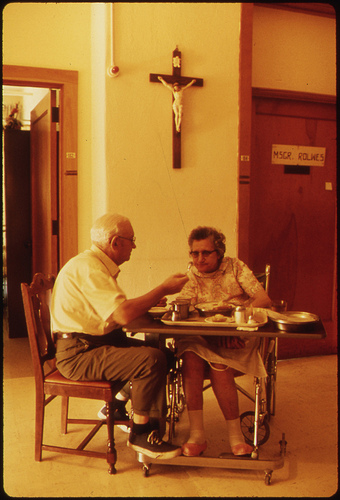

There is probably no one disease that so fully encompasses the intersection between geriatrics and palliative care as doesadvanced dementia. There is a high prevalence of distressing symptoms such as pain and dyspnea, which only become more common as the disease progresses. There is significant functional decline, caregiver distress, and great need for advanced care planning. There is also a very high likelihood that individuals with very advanced disease will undergo burdensome interventions that offer little evidence of benefit.
A great example of one intervention that offers little in the way of benefit and yet iscommonly performed in advanced dementia is the feeding tube. Despite a complete lack of evidence to show any benefit in regards to preventing aspiration pneumonias and pressure ulcers, improving comfort, or prolonging life, feeding tubes are still placed.
One reason I often hear why feeding tube prevalence is high in individuals with advanced dementia is that many family members have unreasonable expectations about the benefits. Research by Joan Teno and colleagues should give us great pause in blaming family members for making such a decision.
Dr. Teno’s study “Decision-Making and Outcomes of Feeding Tube Insertion: A Five-State Study” was published in JAGS in May and was discussed in an excellent NY Times New Old Age piece by Paula Span. The authors interviewed 486 next-of-kin of decedents whose death certificates recorded dementia as the primary cause of death. These individuals came from 5 different states – 2 states with low rates of feeding tube use (MN and MA) and 3 with a high prevalence for feeding tube (AL, FL, TX).
To be included in the survey, these family members had to report that either a feeding tube was inserted, a decision was made not to insert a feeding tube, or that at least one of 3 risk factors were present: an eating problem that resulted in the patient not taking enough nourishment, choking on food, and visible weight loss from not eating enough food.
The interviews occurred on average 2 years after the nursing home resident’s death, so there may be some recall issues. But what the authors did find reaffirmed my belief for the importance of integrating both geriatrics and palliative care.
Overall, 11% of decedents with dementia had a feeding tube inserted. For those decedents who had a feeding tube inserted, the authors found that:
- 14% next-of-kin reported that there was no discussion with a healthcare provider before the insertion of that feeding tube (91% of these family members believed that a discussion should have occurred).
- Even if the next-of-kin reported a discussion prior to feeding tube insertion, nearly half (42%) reported that the conversation lasted less than 15 minutes.
- Discussion of the risks of feeding tube insertion occurred in only half of the cases.
- The possibility of hand-feeding was not discussed in nearly one-third of the cases.
- 38% of the time a physician was “strongly in favor” of inserting a feeding tube.
- 11% of respondents stated that the physician pressured them to put in a feeding tube.
- 26% stated that a feeding tube was inserted to make it easier for staff to feed the patient.
The authors also looked at the outcomes of feeding tube insertion. Here is what they found:
- 26% of the decedents were physically restrained after feeding tube placement.
- 29% of the decedents needed sedating medications to prevent them from pulling out the feeding tube
- 40% of family members stated that the feeding tube seemed to bother the patient.
- Only one third of family members believed the feeding tube improved the patent’s quality of life
- Nearly a quarter (23%) of family members stated that they regretted the decision to insert the feeding tube.
This study highlights the importance of not just talking about the lack of benefits of feeding tubes, but the high risk of adverse events and possible options like careful hand feeding. Patients and family members may have very different ideas on the value of feeding tubes if they hear that nearly 40% of tube fed individuals need to be physically or pharmacologically restrained in order to keep feeding tubes in place.
by: Eric Widera



